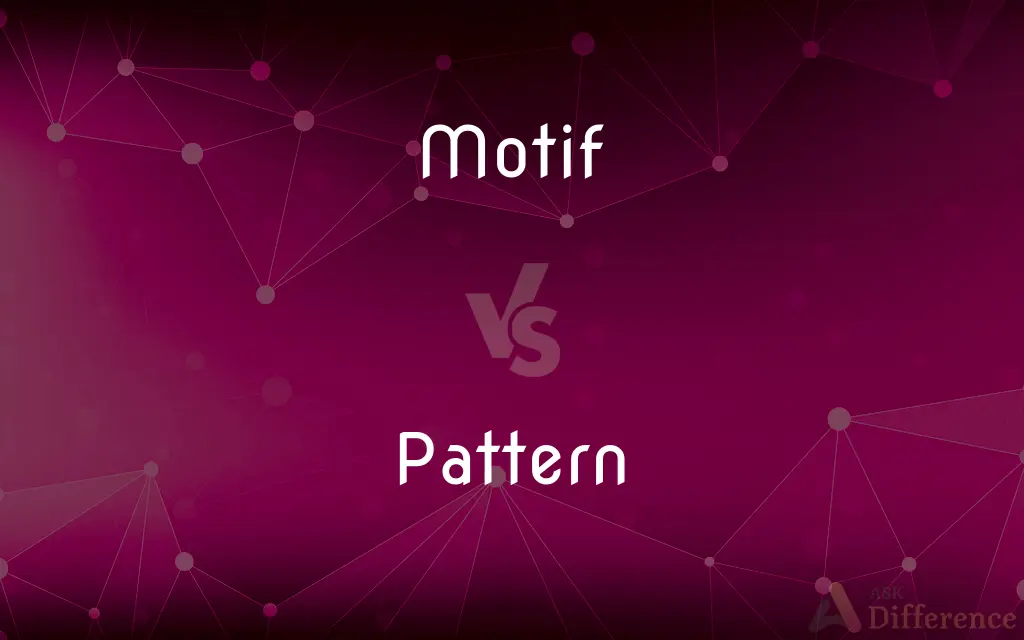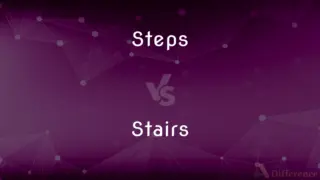Motif vs. Pattern — What's the Difference?
By Tayyaba Rehman & Maham Liaqat — Updated on March 9, 2024
A motif is a distinctive and recurring design, symbol, or theme in art or literature, focusing on symbolic representation, while a pattern is a repeated decorative design, emphasizing regularity and consistency in various contexts.

Difference Between Motif and Pattern
Table of Contents
ADVERTISEMENT
Key Differences
A motif in literature or art serves as a recurring element that has symbolic significance to the theme, character development, or narrative direction. It enriches the work by adding depth and fostering connections among different parts of the text or artwork. On the other hand, a pattern refers to a sequence or combination of elements that are repeated in a predictable manner. It is commonly used in design, mathematics, and the sciences to identify regularities that can predict future occurrences or organize information effectively.
Motifs are often unique to their narrative or artistic context, providing insights or highlighting themes specific to the work. They can be visual, structural, or conceptual, and their repetition enhances the work's aesthetic or thematic coherence. Patterns, whereas, are more generic and can be found across a wide range of fields, serving as a fundamental principle for organizing elements, whether in textile designs, data sequences, or behavioral studies.
While motifs are used deliberately by creators to convey deeper meanings or unify disparate elements within a work, patterns can emerge naturally or be intentionally designed. Patterns serve as a backbone for establishing rhythm, harmony, and structure in various disciplines, from art and architecture to computer algorithms and natural phenomena.
The interpretation of motifs requires understanding of the context and symbolism within a specific work, inviting analysis and interpretation that adds layers of meaning. Patterns, on the other hand, often focus on the arrangement and predictability of elements, which can be analyzed mathematically or visually without needing to delve into symbolic significance.
Motifs and patterns, despite their differences, both play crucial roles in adding complexity and interest to their respective fields. A motif’s value lies in its ability to signify and symbolize, enriching narratives and artistic expressions, while the utility of a pattern lies in its ability to organize, predict, and structure, providing clarity and consistency across various applications.
ADVERTISEMENT
Comparison Chart
Definition
A recurring element with symbolic significance in art or literature.
A repeated design or sequence, emphasizing regularity.
Purpose
To add depth, foster connections, and enrich thematic coherence.
To establish rhythm, harmony, and structure.
Context
Unique to its narrative or artistic context.
Generic, applicable across various fields.
Interpretation
Requires contextual and symbolic understanding.
Analyzed for arrangement and predictability, often mathematically.
Application
Enhances aesthetic or thematic coherence in creative works.
Organizes information, predicts future occurrences.
Compare with Definitions
Motif
A motif is a recurring symbol in literature.
The motif of light and dark in Romeo and Juliet symbolizes the contrast between love and hate.
Pattern
A pattern is a repeating design in textiles.
The floral pattern on the dress consists of repeating roses.
Motif
A musical motif is a short recurring musical idea.
The four-note motif in Beethoven's Symphony No. 5 represents fate knocking at the door.
Pattern
In behavior, a pattern refers to habitual actions.
His morning pattern includes a run at dawn.
Motif
A narrative motif is a repeated element that contributes to the theme.
The motif of the hero's journey appears across cultures and epochs.
Pattern
Patterns in nature are often symmetrical or fractal.
The pattern of snowflakes demonstrates radial symmetry.
Motif
A motif in art emphasizes visual symbols to convey themes.
The recurring use of water in Hokusai's prints represents change and fluidity.
Pattern
Mathematical patterns follow specific rules.
The sequence of prime numbers is a well-known mathematical pattern.
Motif
A motif in design refers to a recurring thematic element.
The use of geometric motifs in Islamic art symbolizes the infinite.
Pattern
A pattern in data shows trends or regularities.
The pattern in the sales data indicates a seasonal increase.
Motif
A repeated figure or design in architecture or decoration.
Pattern
A pattern is a regularity in the world, in human-made design, or in abstract ideas. As such, the elements of a pattern repeat in a predictable manner.
Motif
A recurrent thematic element in an artistic or literary work.
Pattern
A usually repeating artistic or decorative design
A paisley pattern.
Motif
A dominant theme or central idea.
Pattern
A natural or accidental arrangement or sequence
The pattern of rainfall over the past year.
Motif
(Music) A short rhythmic or melodic passage that is repeated or evoked in various parts of a composition.
Pattern
A plan, diagram, or model to be followed in making things
A dress pattern.
Motif
A recurrent pattern either of molecular sequence, usually of nucleotides or amino acids in proteins, or of molecular structure that usually corresponds to specific biological activity.
Pattern
A model or original used for imitation or as an archetype.
Motif
A recurring or dominant element; an artistic theme.
See how the artist repeats the scroll motif throughout the work?
Pattern
A composite of traits or features characteristic of an individual or a group
One's pattern of behavior.
Motif
(music) A short melodic or lyrical passage that is repeated in several parts of a work.
Pattern
Form and style in an artistic work or body of artistic works.
Motif
A decorative figure that is repeated in a design or pattern.
Pattern
The configuration of gunshots upon a target that is used as an indication of skill in shooting.
Motif
(dressmaking) A decorative appliqué design or figure, as of lace or velvet, used in trimming.
Pattern
The distribution and spread, around a targeted region, of spent shrapnel, bomb fragments, or shot from a shotgun.
Motif
(crystallography) The physical object or objects repeated at each point of a lattice. Usually atoms or molecules.
Pattern
Enough material to make a complete garment.
Motif
(chess) A basic element of a move in terms of why the piece moves and how it supports the fulfilment of a stipulation.
Pattern
A test pattern.
Motif
(biochemistry) In a nucleotide or aminoacid sequence, pattern that is widespread and has, or is conjectured to have, a biological significance.
Pattern
The flight path of an aircraft about to land
A flight pattern.
Motif
Motive.
Pattern
(Football) A pass pattern.
Motif
In literature and the fine arts, a salient feature or element of a composition or work; esp., the theme, or central or dominant feature;
This motif, of old things lost, is a favorite one for the serious ballade.
The design . . . is . . . based on the peacock - a motif favored by decorative artists of all ages.
Pattern
To make, mold, or design by following a pattern
We patterned this plan on the previous one. My daughter patterned her military career after her father's.
Motif
A decorative appliqué design or figure, as of lace or velvet, used in trimming; also, a repeated design.
Pattern
To cover or ornament with a design or pattern.
Motif
A design that consists of recurring shapes or colors
Pattern
To make a pattern.
Motif
A theme that is elaborated on in a piece of music
Pattern
Model, example.
Motif
A unifying idea that is a recurrent element in a literary or artistic work;
It was the usual `boy gets girl' theme
Pattern
Something from which a copy is made; a model or outline.
Pattern
Someone or something seen as an example to be imitated; an exemplar.
Pattern
A copy.
Pattern
A sample; of coins, an example which was struck but never minted.
Pattern
A representative example.
Pattern
(US) The material needed to make a piece of clothing.
Pattern
(textiles) The paper or cardboard template from which the parts of a garment are traced onto fabric prior to cutting out and assembling.
Pattern
A full-sized model around which a mould of sand is made, to receive the melted metal. It is usually made of wood and in several parts, so as to be removed from the mould without damage.
Pattern
(computing) A text string containing wildcards, used for matching.
There were no files matching the pattern
*.txt.Pattern
A design pattern.
Pattern
Coherent or decorative arrangement.
Pattern
A design, motif or decoration, especially formed from regular repeated elements.
Pattern
A naturally-occurring or random arrangement of shapes, colours etc. which have a regular or decorative effect.
Pattern
The given spread, range etc. of shot fired from a gun.
Pattern
A particular sequence of events, facts etc. which can be understood, used to predict the future, or seen to have a mathematical, geometric, statistical etc. relationship.
Pattern
(linguistics) An intelligible arrangement in a given area of language.
Pattern
A sequence of notes, percussion etc. in a tracker module, usable once or many times within the song.
Pattern
To apply a pattern.
Pattern
To make or design (anything) by, from, or after, something that serves as a pattern; to copy; to model; to imitate.
Pattern
To follow an example.
Pattern
To fit into a pattern.
Pattern
(transitive) To serve as an example for.
Pattern
To observe an animal closely over time in order to discern its habitual movements and behaviours.
Pattern
(MLE) To arrange, to organise, to fix.
Pattern
Of or in accordance with a usual pattern, or type; model; ideal.
Pattern
Anything proposed for imitation; an archetype; an exemplar; that which is to be, or is worthy to be, copied or imitated; as, a pattern of a machine.
I will be the pattern of all patience.
Pattern
A part showing the figure or quality of the whole; a specimen; a sample; an example; an instance.
He compares the pattern with the whole piece.
Pattern
Stuff sufficient for a garment; as, a dress pattern.
Pattern
Figure or style of decoration; design; as, wall paper of a beautiful pattern.
Pattern
Something made after a model; a copy.
The patterns of things in the heavens.
Pattern
Anything cut or formed to serve as a guide to cutting or forming objects; as, a dressmaker's pattern.
Pattern
A full-sized model around which a mold of sand is made, to receive the melted metal. It is usually made of wood and in several parts, so as to be removed from the mold without injuring it.
Pattern
A recognizable characteristic relationship or set of relationships between the members of any set of objects or actions, or the properties of the members; also, the set having a definable relationship between its members.
Pattern
A diagram showing the distribution of the pellets of a shotgun on a vertical target perpendicular to the plane of fire.
Pattern
The recommended flight path for an airplane to follow as it approaches an airport for a landing. Same as landing pattern.
Pattern
An image or diagram containing lines, usually horizontal, vertical, and diagonal, sometimes of varying widths, used to test the resolution of an optical instrument or the accuracy of reproduction of image copying or transmission equipment. Same as test pattern.
Pattern
To make or design (anything) by, from, or after, something that serves as a pattern; to copy; to model; to imitate.
[A temple] patterned from that which Adam reared in Paradise.
Pattern
To serve as an example for; also, to parallel.
Pattern
A perceptual structure;
The composition presents problems for students of musical form
A visual pattern must include not only objects but the spaces between them
Pattern
A customary way of operation or behavior;
It is their practice to give annual raises
They changed their dietary pattern
Pattern
A decorative or artistic work;
The coach had a design on the doors
Pattern
Something regarded as a normative example;
The convention of not naming the main character
Violence is the rule not the exception
His formula for impressing visitors
Pattern
A model considered worthy of imitation;
The American constitution has provided a pattern for many republics
Pattern
Something intended as a guide for making something else;
A blueprint for a house
A pattern for a skirt
Pattern
The path that is prescribed for an airplane that is preparing to land at an airport;
The traffic patterns around O'Hare are very crowded
They stayed in the pattern until the fog lifted
Pattern
Graphical representation (in polar or cartesian coordinates) of the spatial distribution of radiation from an antenna as a function of angle
Pattern
Plan or create according to a model or models
Pattern
Form a pattern;
These sentences pattern like the ones we studied before
Common Curiosities
Can a motif be a pattern?
While a motif can form a pattern through repetition, its symbolic significance differentiates it from a general pattern.
How do patterns differ in art and science?
In art, patterns are decorative sequences, while in science, they represent predictable sequences or structures.
What defines a motif in literature?
A motif in literature is defined by its symbolic repetition throughout a narrative, enhancing themes or character development.
Are patterns important in fashion?
Patterns are crucial in fashion for creating visual interest, harmony, and rhythm in designs.
What is an example of a pattern in nature?
The Fibonacci sequence is an example, appearing in phenomena like the arrangement of leaves on a stem.
Why are motifs important in storytelling?
Motifs enrich storytelling by adding layers of meaning, fostering thematic coherence, and enhancing symbolism.
What role do motifs play in film?
Motifs in film visually or narratively repeat elements to reinforce themes, character arcs, or plot points.
Can a single work have multiple motifs?
Yes, a work can have multiple motifs, each adding complexity and depth to the narrative or thematic structure.
Why is the repetition of motifs significant?
Repetition emphasizes the motif’s importance, making its symbolism more potent and integral to understanding the work.
How are patterns used in mathematics?
Patterns in mathematics help identify regularities, solve problems, and predict future events.
How do motifs contribute to a work’s theme?
Motifs contribute by symbolically reinforcing and echoing the work’s central themes.
What's the difference between a pattern and a trend?
A pattern is a repeating sequence, while a trend indicates a general direction in which something is developing or changing.
Do patterns have symbolic meaning like motifs?
Generally, patterns focus more on structure and regularity than on symbolic meaning.
How does one identify a motif in literature?
Identify motifs by noting recurring symbols, themes, or narrative elements that enhance the work's deeper meanings.
How do patterns help in problem-solving?
Recognizing patterns allows for predicting outcomes and formulating strategies based on observed regularities.
Share Your Discovery

Previous Comparison
Melon vs. Pumpkin
Next Comparison
Steps vs. StairsAuthor Spotlight
Written by
Tayyaba RehmanTayyaba Rehman is a distinguished writer, currently serving as a primary contributor to askdifference.com. As a researcher in semantics and etymology, Tayyaba's passion for the complexity of languages and their distinctions has found a perfect home on the platform. Tayyaba delves into the intricacies of language, distinguishing between commonly confused words and phrases, thereby providing clarity for readers worldwide.
Co-written by
Maham Liaqat













































